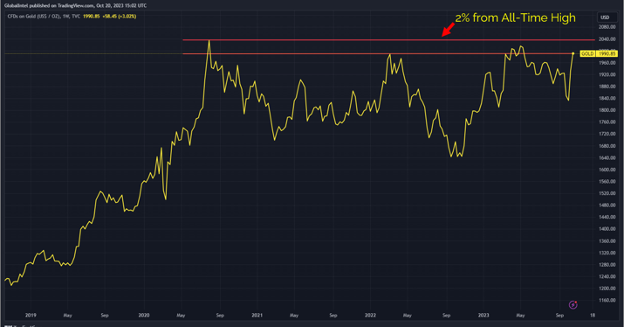The Asset That Makes Ivory Tower Economists Look Like Fools
Does something evil this way come?
The gold market seems to think so.
You’ve probably not heard much about gold in recent months. I haven’t, and I pay attention to this stuff more intently than most. The financial media has been largely quiet about gold, focused more on the bond market and stocks, both of which have been falling since mid-summer.
Gold, however, is within two percent of its all-time high set back in 2020.
As I write this, gold is at $1,990 per ounce. All-time high: $2,035… a 2% difference.

And here’s what makes that all the more interesting in terms of evil creeping our way: Bond prices, as I noted, are down. Which means yields are up. Three-month Treasury bills right now are yielding 5.45%. Six-months are at 5.53%. Invest for a year and you get 5.41%. Go out five or 10 years and you’re at basically 4.9%. And if you want to stretch all the way to 30 years, you’d lock in a 5.1% annual return for doing nothing but holding Treasuries and playing bridge all day.
In theory, that should be sour news for gold.
See, gold pays no dividends. It earns no interest. It just sits in a vault or a safe-deposit box, collecting dust in the dark.
So, anytime investors can earn a nice, safe yield on U.S. Treasury paper, why would they want to own an asset that offers them no income whatsoever?
At least that’s what the Ivory Tower crowd tells us.
But gold never went to school to earn a degree in make-believe. It graduated from the University of Real Life, where there are no professors pushing thoughts on what should happen. Gold plays by street rules, the harshest rules.
And here on the street, gold prices are going up because gold investors see Trouble with a capital T looming.
China is struggling economically.
Germany, the growth engine of Europe, is now the sick man of Europe.
And the U.S., while not outwardly struggling, has some internal ailments that will likely bring about a recession. All the research says the U.S. consumer is tapped out, with the middle- and lower-classes having drained its record-level post-COVID savings. They’ll hang on for a while because they’re living on the good graces of American Express and Mastercard.
But with more than $1 trillion in cumulative credit card debt these days, and with higher interest rates pulling more and more money out of family income streams, the American consumer’s ability to hang on has a shelf life.
We also have a conflict in the Middle East that has all the right ingredients to morph into something bigger and badder.
Perhaps most worrying, though, are those Treasury yields that are near or above 5%.
That’s the bond market in collapse.
That’s bond buyers globally shunning Uncle Sam, forcing our over-indebted overlord to shell out problematically more and more money as interest payments. Though I have been warning about this moment for well over a year, only now are mass-media headlines popping up and noting that high interest rates are creating a financial problem for the U.S., and that bond buyers are avoiding the Treasury Dept.’s bond auctions because they don’t want to own the debt of a country that so clearly has a monetary crisis coming.
And, so, gold is reacting to that.
In the stock market, a high dividend yield on a supposedly blue-chip company is quite often a warning sign that operational problems are afoot, though they’ve not fully manifested yet.
The same might be said in the market for American debt…
Where a 5% yield was normal 20 years ago, today it’s a sign of growing distress in the finances of a nation that has become so addicted to debt, it survives on it to keep the lights on every year.
I say this over and over, but the guys and gals in the bond markets—they’re the smartest people in any room. They’ve pushed up bond yields because they’re seriously worried about a fiscal/monetary crisis in Uncle Sam’s house.
The gold market sees that.
And the gold market is saying, “Look, I didn’t go to college and read all those stupid textbooks… but those bonds jockeys did, and they’re the only jockeys I trust. And they’re saying the fan is about to meet up with a mountain of kaka. So, up we go, boys!”
And that’s why gold is up quietly, to within a hair of its all-time high, even as rising bond prices would, academically speaking, suggest the opposite should be occurring.
This is why I’ve been saying for a decade: Pad your portfolio with gold.
It’s lifestyle insurance for what’s now taking shape.
The bond market is warning you. And the gold market is amplifying the message.
Not signed up to Jeff’s Field Notes?
Sign up for FREE by entering your email in the box below and you’ll get his latest insights and analysis delivered direct to your inbox every day (you can unsubscribe at any time). Plus, when you sign up now, you’ll receive a FREE report and bonus video on how to get a second passport. Simply enter your email below to get started.
